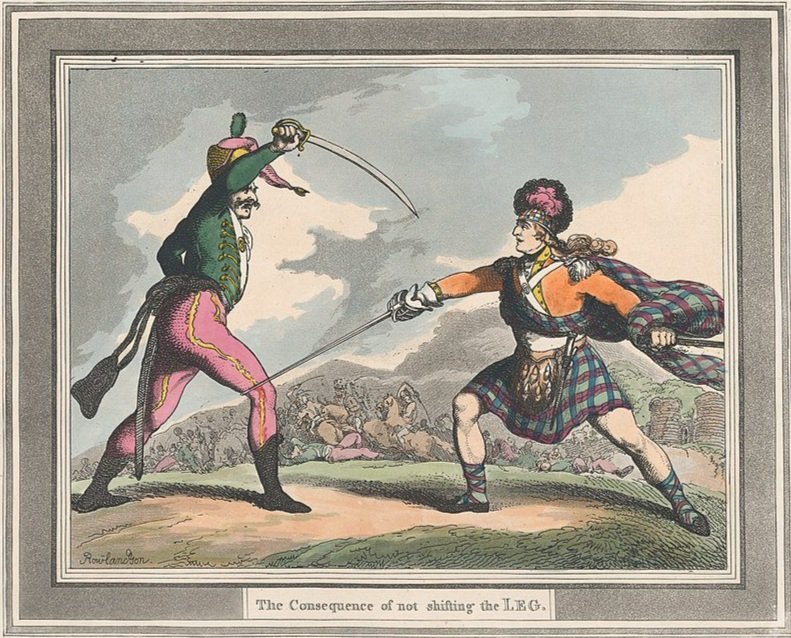
OUR BROADSWORD/SABER CLASSES
Thursdays at 6:30PM-7:30PM
Have you ever wondered what it was like to fight like Scottish highlanders? The Scottish broadsword is one of many 18th and 19th century swords including spadroons, sabers, and great swords used by Scottish warriors across the ages. It evolved out of many models of British basket-hilted swords of all shapes and sizes. They are characterized as straight, single or double-edged blades that are protected by a symmetrical, pierced metal basket. Though less common, curved blades did exist gaining popularity in the mid to late 18th century. They had thick, stiff blades with a great amount of distal taper lending themselves to deadly blows.
The typical blade length can range from 30-38 inches in length. This deadly martial art was written down and preserved through the ages by great masters like McBane, Roworth, Mathewson, Taylor, Sinclair, Silver, Sorlie, Page, Angelo, and Ferdinand.
The British saber shares a lot of techniques with the highland broadsword, even though sabers typically have a move curved blade. Because manuals on the broadsword apply to many swords such as a spadroon, stick, and saber, the techniques we teach can be used for multiple weapons.
We have found that our combination of referencing historical sources and organically working through concepts through drills and sparring results in people understanding the art of the sword most effectively! Feel free to reach out about our classes at any time if you have questions! Visit our GEAR GUIDE page to see what equipment you need to get started!
GALLERY












SCOTTISH BROADSWORD AND SABRE
The basket-hilted sword is a development of the 16th century, rising to popularity in the 17th century and remaining in widespread use throughout the 18th century, used especially by heavy cavalry up to the Napoleonic era.
During the 18th century, the fashion of duelling in Europe focused on the lighter small sword, and fencing with the broadsword came to be seen as a speciality of Scotland. A number of fencing manuals teaching fencing with the Scottish broadsword were published throughout the 18th century.
A common weapon among the clansmen during the Jacobite rebellions of the late 17th and early 18th centuries was the Scottish basket hilted broadsword, commonly known as claidheamh mor or claymore meaning "great sword" in Gaelic. Descendants of the basket-hilted sword, albeit in the form of backswords with reduced "half" or "three-quarter" baskets, remained in use in cavalry during the Napoleonic era and throughout the 19th century down to the eve of World War I. One of the last active use of the Scottish broadsword in war was in World War II by Major Jack Churchill.
THE SABER - A PROVEN MILITARY SWORD
The Sabre is a type of sword that has a curved blade and a single edge. It has a long and fascinating history that dates back to the 16th century. Originally designed in the Middle East, the Sabre spread throughout Europe and Asia, becoming one of the most popular and effective weapons in military history. The Sabre was widely used in the military, particularly by cavalry units. Its design allowed for quick and precise slashes, making it an ideal weapon for mounted soldiers. The Sabre was also used by foot soldiers, and its effectiveness led to its adoption by many armies around the world.
MARTIAL ARTS SYSTEMS WERE BUILT AROUND IT
Passed down clan to clan, many highlanders were skilled in the use of the broadsword. Used to lethal effect in the North American conflicts, its effect was known around the world! In America the first recorded sword school was opened in the Old West Church by an old Scottish soldier Donald McAlpine.
Carrying the tradition in 1790, an anonymous Highland Officer (who we now know to have been a Captain G. Sinclair) published Anti-Pugilism, or the Science of Defence, describing the broadsword and singlestick play he had learned in his military service in the Black Watch. This was the first of a series of late-period Highland Broadsword manuals, written by or for soldiers in the British Army, particularly the famous Highland Regiments. In 1791, a fencing instructor named Archibald MacGregor published a Lecture on the Art of Defence, in which he discussed the use of a number of weapons, including the broadsword.
In 1799, Henry Angelo (son of the great smallsword fencer Domenico Angelo) published a poster called The Guards and Lessons of the Highland Broadsword, illustrated by Rowlandson. This poster illustrated eight guards. The same year, he published Hungarian and Highland Broadsword, which was intended as a training manual for English cavalrymen who had adopted the Highland broadsword for their own use.




